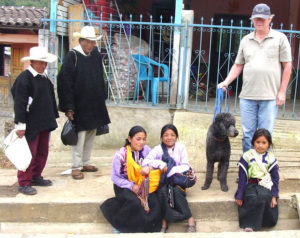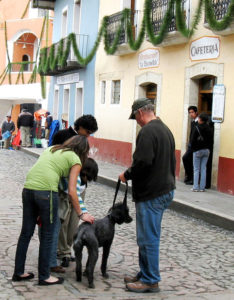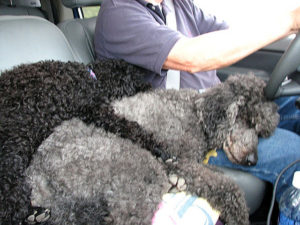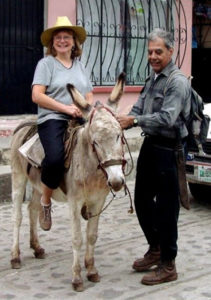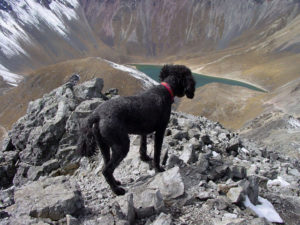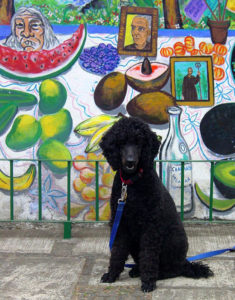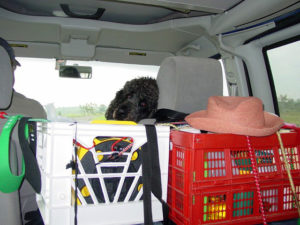Los perros go everywhere with us, including to Mexico. Milo, a charcoal-hued Standard Poodle, is a veteran of seven such trips. He has reached the summit of the Nevada de Toluca volcano, walked into Guatemala, swum in the Pacific, Gulf and Sea of Cortez, explored the Copper Canyon, and visited almost every state in Mexico. Pancho Villa, (a black mini-Milo) just completed his third trip. They have made many friends and even learned some Spanish.
 Having a sociable pet with you can be a real icebreaker. Parents love to bring (or sometimes drag) their children over to pet the pups. Adolescent girls positively swoon over them. But first, onlookers almost invariably ask, “¿muerden?” — do they bite? Frequent questions concern the dogs’ breed (raza), age, and names. In some areas, particularly Chiapas, admirers are more forward and ask how much they cost. I’ve learned to artfully dodge that question.
Having a sociable pet with you can be a real icebreaker. Parents love to bring (or sometimes drag) their children over to pet the pups. Adolescent girls positively swoon over them. But first, onlookers almost invariably ask, “¿muerden?” — do they bite? Frequent questions concern the dogs’ breed (raza), age, and names. In some areas, particularly Chiapas, admirers are more forward and ask how much they cost. I’ve learned to artfully dodge that question.
To liven things up, we’ve taught the boys dog tricks in both English and Spanish. I tell Mexican children that they are bilinqüe, which elicits either a verdad? (really?) — or a good laugh. In reality, they are mostly responding to hand signals to sit, lie down and shake hands. Pancho Villa also will dance. His name usually elicits chortles. Sometimes we heap it on by telling people that Milo is short for Emiliano Zapata.
There are a few drawbacks to traveling with pets in Mexico. One is finding pet-friendly lodging, something I will address below. Another is the absence of really good, safe places for them to run, aside from the beaches. You can’t take pets on buses and cab drivers will sometimes refuse you transport. Finally, it is difficult to visit indoor attractions and archeological sites with your pals in tow. It often will be too warm to leave them in you vehicle.
My husband and I sometimes take turns touring sites restricted to hominoids. We’ve also engaged attendants to dog-sit. For instance, at Teotihuacan, we tied them outside our van in the shade of a tree and tipped the parking lot attendants for keeping an eye on them. At the new textile museum in San Augustin Etla, Oaxaca, the ticket taker, seated at an outdoor table, was delighted to look after them in exchange for a modest tip. In Real de Asientos, northeast of Aguascalientes, a church office employee took charge of them while we went on the underground tour beneath the church. When we emerged, we found half the town crowding into the office to make our furry pals’ acquaintance.
Crossing the borders
The first question people ask about bringing a pet into Mexico concerns the paperwork. This question begets another one, do you want a legal or a reality based answer? Mexico hands are familiar with the bureaucracy administering poorly understood regulations that often are honored in their breach. The requirements for importing pets are illustrative. (Note that the Mexican government defines a pet as a dog or cat only and this discussion is confined to these two species).
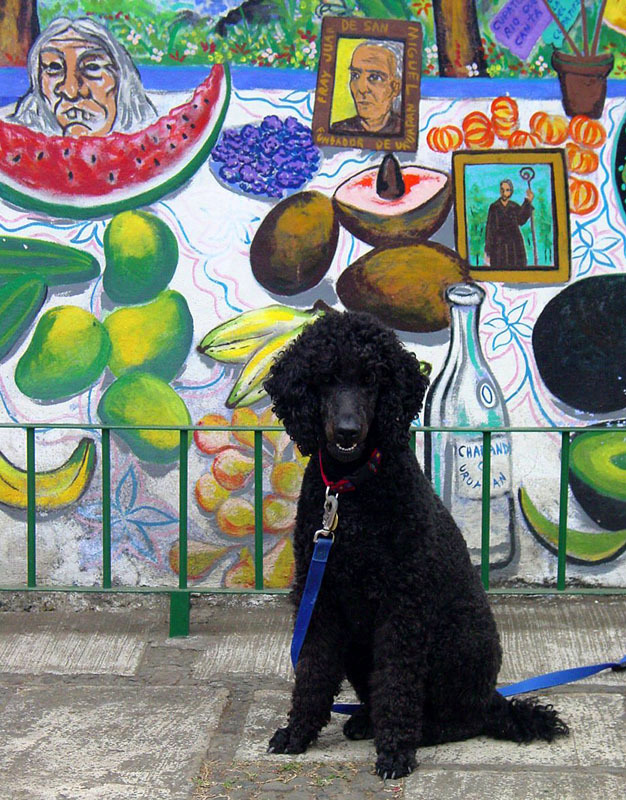
Let’s start with the legal. I searched the Internet and perused about a dozen websites, including those of the Mexican embassy in Washington and the U.S. State Department, which purport to spell out pet import requirements. I found no two alike. The most reliable source, I believe, is the website of Mexico’s agricultural agency, SENASICA. That site attempts an awkward English translation, but I chose to do my own, in part to amuse myself reading requirements that are as obtuse as anything in the U.S. Code of Federal Regulations. My synthesis of agency’s requirements is as follows.
According to SENASICA, to bring your pet into Mexico, you will need a certification from a veterinarian written on a letterhead showing his or her credentials (or alternatively, a copy of the vet’s license) containing:
- The name, age, and breed of the animal along with your name and home address.
- A statement that the vet has examined the pet and found it to be clinically healthy
- A statement that the pet has been immunized against rabies within 12 months prior to entry; the type of vaccine used should be indicated. Alternatively, a copy of the vaccination certificate is acceptable. Pets less than three months old are exempt from this requirement.
- A statement that the pet has undergone a parasitic prevention treatment (which should be described). Alternatively, the certification may contain a statement that an examination of the animal showed it to be free from internal and external parasites. This information can be provided on an accompanying vaccination certificate.
- The vet’s signature along with the date signed, which can be no more than five days prior to your entry into Mexico.
You are required to bring an original and one photocopy of the above documents and present them and your pet to the Office of the Inspector for Agricultural Health at your port of entry.
Contrary to the assertions of countless web sites, SENASICA does not require any other vaccinations except rabies. Presumably, however, you are current with the vaccines recommended by your vet and it is a good idea to bring a couple of copies of the vaccination certificate along.
As I read the above requirements, you do not need a certificate on any kind of official agricultural form. This is important because your vet may assume a certain form is needed and may charge (a great deal) accordingly. A “certification” alone means nothing more than a simple declarative statement along the lines of: “I certify that I have examined the above-named animal and found it to be clinically healthy and free from external and internal parasites.”
I recommend asking your vet whether there is a separate charge for a health certificate, over and above the charge for the health examination. We have visited two vets who have charged significantly extra, although I have heard of other vets who have not added any extra fee. If your vet intends to charge, he or she might have in mind an agricultural certification that involves more than the simple certification required by the Mexican government. You should explain that all that is needed is a simple statement like that suggested above, written on a letterhead showing the vet’s name and credential (i.e., DVM).
Now for the reality. We have driven across the border seven times with our animals and have never complied with the letter of the law, partially out of ignorance. The veterinary certifications we obtained did not contain the statement about parasites. And we never darkened the doors of an agricultural inspector. Only once have we showed the certification to a border guard. He only glanced at the paperwork and I doubt he could read English. Otherwise, no one has taken any interest in our pups. I’ve asked other dog and cat owners about their experience driving across the border, and it has been the same. We finally quit obtaining any certification. If we’re asked, we’ll produce vaccine and health records, and if confronted, we will turn around and engage a border vet. Alternatively, according to SENSICA, a veterinarian procured by the agency will examine the animal’s health, administer a rabies shot if needed, and collect a fee from the owner. There apparently is no other penalty for not having the required certification.
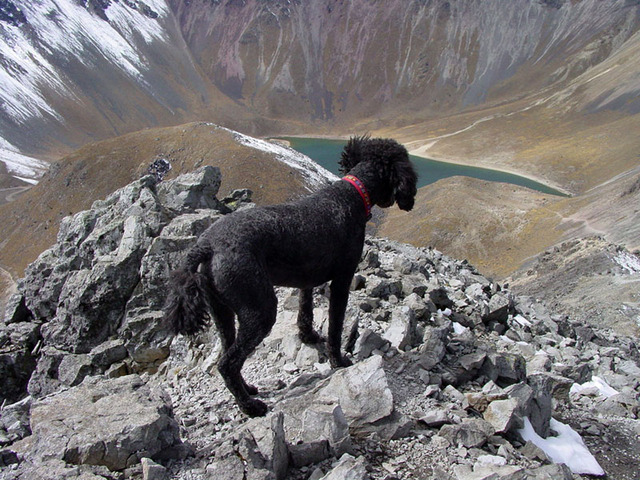
Flying your pet into Mexico is another matter. You must obtain proper veterinary certification and airlines have their own requirements.
Re-entry into the U.S. and Canada requires a rabies vaccination certificate. The pet also should appear to be healthy. We have never been asked for any documentation concerning our dogs when re-entering the U.S.
Other nuts and bolts
Vaccinations You will want your pets to have the usual panoply of vaccinations. In addition, you may want your dog to be treated for heartworm, even if it’s not present where you live. There are a number of tick-borne diseases in parts of Mexico, so I recommend asking you vet about tick treatment.
Flea, Tick and Heartworm treatment Frontline, Advantage and Revolution, among others, may be obtained from vets in Mexico, but will cost you more than in the U.S. or Canada.
I.D. Tags I recommend obtaining identification tags that show your e-mail address, a cell phone number (if you have one), and any additional contact information in Mexico. If the unthinkable happens and your pet gets lost, you’ll want a Mexican Good Samaritan to be able to easily contact you. There are several vendors on the Internet that will cram a lot of information on a tag and/or will engrave on both sides. Our dogs are micro-chipped but I question whether that would be useful in Mexico.
Pet Food Not all brands of premium dog-food or cat food may be found in Mexico. Some veterinarians carry a brand such as Science Diet. The price probably will be higher than in the U.S. or Canada. Supermarkets sometimes carry a higher end Purina brand. If you or your pets are picky, I suggest you pack enough to last you the entire trip.
First Aid Your basic first aid supplies can be purchased in Mexico, but it is handy to have antibiotic ointment along as well as hydrogen peroxide. The latter is needed to induce vomiting if your pet consumes a toxic substance and no vet can be found. We learned this the hard way when Milo ate some D-Con rodnet poison late at night. Talk to your vet about other things you should take. Also have handy the phone number for the ASPCA’s 24-hour poison hotline, which is (from Mexico to the U.S.) 001-888-426-4435. They saved Milo’s hide after the aforesaid midnight D-Con incident and we gladly paid the $60 fee.
Veterinarians Vets, as a rule, do not have the training that they do in the U.S., but there are exceptions. If you need a vet and have the luxury of being able to ask around, then do so. We had an emergency in Oaxaca when we discovered a thorn had badly infected Milo’s paw. The vet’s facilities were primitive, but she did a good job of treating him.
Grooming Most vets (or their assistants) are willing to groom dogs. Look for “estética” as one of their listed services. Their fees are about a third of what is charged north of the border. There also are some stand-alone grooming salons in places where more pampered pooches are apt to be found. If you have a particular style haircut in mind, you might want to bring a photo or illustration with you to show the groomer. We’ve encountered groomers who have helpful pictures or illustrations on file for various breeds and looks.
Finding accommodations
We like to drive and explore, sometimes in out-of-the way places. We quickly found that finding lodgings that will accept pets can be challenging. Mexicans, as a rule, do not travel with their dogs or cats in tow. Mexican hotel clerks react as though you checked your brains at the border when you tell them that you want to share your bedroom with an animal that in their view, generally sleeps on roof tops, the yard, or in the streets. We finally purchased a small camper, but that solution is not for everyone and it lacks the versatility of traveling by car.
Look online to find pet-friendly abodes. Be aware also that some places will allow pets one day and not the next, apparently at the whim of the desk clerk. It helps, I believe, to “sell” yourself and your pet to the manager or desk clerk by emphasizing your pet’s good attributes and behavior. (Having a small animal can be especially advantageous). For those of you who are challenged with Spanish, I have written out a sales pitch to deliver to the person in charge. Be sure to modify it to fit your situation. For instance, don’t promise a perrito pequeño and then show up with a Mastiff. If your pet is a cat, substitute gatito for perrito. Here it is:
Tengo un perrito y yo quisiera llevarlo a la habitación. Tengo una casita para perros. [OR] Tengo una cama conmigo para el perro. No le permitiré tener acceso a las camas o los muebles en la habitación. El perrito no tiene pulgas ni parásitos, es limpio, no muda pelo, y está de buena salud. No ladra ni muerde. Está bien educado y yo puedo recoger su popó afuera, si quiere. También, le prometo que no dejaré a mi perrito solo en la habitación. ¿No tiene inconveniente en que lleve a mi perrito a la habitación?
Translated, this says:
I have a pooch and I would like to take it into the room. I have a kennel for dogs [OR] I have a dog bed with me. I will not allow it on the beds or furniture in the room. The dog does not have fleas or parasites, it is clean, it does not shed and it is healthy. It won’t bark or bite. It is house-trained and I am willing to clean up its mess outside, if you’d like. Also I promise not to leave my dog alone in the room. Would you allow me to bring it into the room? You may wonder about the word perrito, which would normally be translated as “little dog.” We’ve heard countless Mexicans refer to our 50-pound poodle as a “perrito,” suggesting that it is more a term of endearment than a reference to the size of your pet.
Another recommendation is to e-mail ahead to the lodgings on your itinerary to inquire whether your pet will be accommodated. If you receive a favorable response, save the e-mail-you may need it as proof. In Mazatlan I had to fire up the laptop to prove that the manager (who was out that day) had indeed assured me that our mutts were welcome. We also had to settle for the worst room in the motel, but we were accustomed to that.
It goes without saying, of course, that you should adhere to your pledge about being a responsible pet owner. I found it telling that the owner of Villa Pátzcuaro, whose motel and RV Park are popular with pet owners, recently sent me a copy of the pet rules he has put in place. The fact that he was moved to develop a list of rules means that some pet owners have not been good guests with their pets.
Buena suerte!
*Andar de pata de perro means to go from one place to another, pausing and investigating, without any fixed destination — as your dog does when given free rein.


